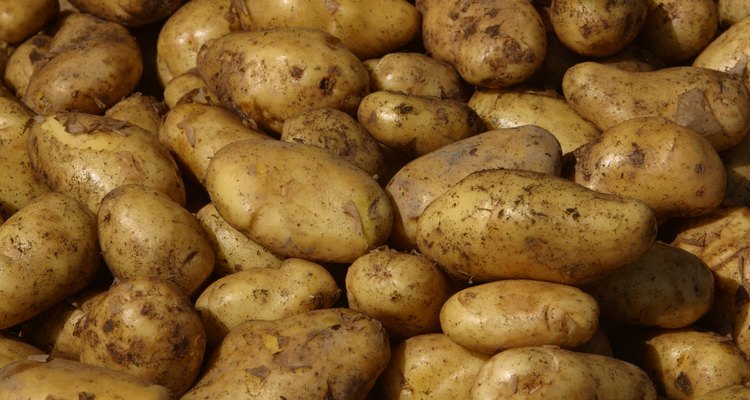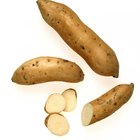
Potatoes provide the backbone in many well-stocked pantries because they store easily and spoil slowly. A baking potato has firm flesh that cooks to a soft, creamy texture inside its sturdy skin. Using a spoiled baking potato ruins the flavor of food and can cause illness if bacteria is present. Use only the healthiest and best-quality baking potatoes, and dispose of those that go bad promptly.
Step 1
Feel the skin of the potatoes. Healthy baking potatoes have smooth skins with no wrinkles and minimal roughness.
Step 2
Check the outside of the potato for cuts, soft spots and mold. Small eyes, or growing buds, don't indicate spoilage, but long sprouts do. You can remove short sprouts if you use the potato immediately, and it shows no other signs of spoilage.
Step 3
Squeeze the potato gently in your hand, rotating and squeezing all sides equally. A good potato feels firm, while a spoiling potato may feel soft or bruised.
Step 4
Examine the color of the baking potato. Baking potatoes typically have brown skin. Dispose of the potato if it shows extensive green color that penetrates deeper than just below the skin. If it only has a small green area under the skin, trim it off with a knife, and the potato is safe to cook and eat. Green indicates light exposure and the production of solanine, which is toxic in large amounts. It first forms near the skin's surface, but penetrates deeper during prolonged exposure.
Related Articles

Can You Bake a Potato That Already Has ...

Can You Eat Green Skins on Potatoes?

What Is the Best Potato for Frying?

How to Boil Potatoes So They Can Be ...

Can You Over-Bake a Potato?

How to Cook Small Dutch Yellow Potatoes

How to Bake a Potato Without an Oven

Can You Store Potatoes in the ...

How to Blanch Red Potatoes for Peeling

How to Steam Cook a Potato

Can You Use an Eggplant if It Has ...

How to Cook Potatoes in Hot Ashes

Why Do You Need to Pierce Potatoes ...

How to Roast Beets for Canning or ...

How to Bake a Potato in 30 Minutes

Can You Eat Peeled Potatoes After ...

How Do I Preserve Sliced Potatoes?

How to Freeze Cherry Peppers

Peeling the Spiny Chayote Squash

The Best Potatoes For Shredded Hash ...
References
Tips
- Store potatoes -- preferably in a dark pantry -- at 45 to 50 degrees Fahrenheit for three or more weeks; store them at room temperature for about one week. If the potatoes are bagged, keep the bag open.
- Check potatoes frequently during storage and remove any that begin to go bad immediately.
- Avoid storing potatoes in the refrigerator because the cold temperature turns the starch into sugar, which changes the flavor and causes them to discolor when cooked.
Writer Bio
Jenny Harrington has been a freelance writer since 2006. Her published articles have appeared in various print and online publications. Previously, she owned her own business, selling handmade items online, wholesale and at crafts fairs. Harrington's specialties include small business information, crafting, decorating and gardening.
Photo Credits
NA/Photos.com/Getty Images